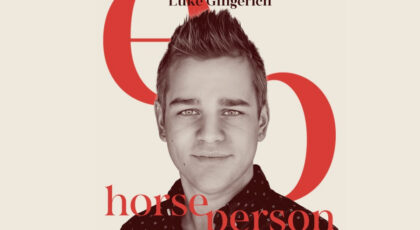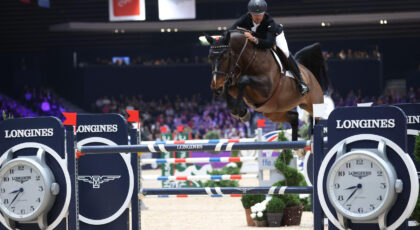Inspired by her own childhood trauma when she spent seven days in a coma, awakened to a severely compromised body and brain, and rebuilt her life with the help of a horse, Michelle Holling-Brooks founded Unbridled Change, a non-profit Equine-Partnered Therapy organization that helps match horses to individuals in need. In her new book The Horse Cure she shares her own story, as well as those of some of the people she’s worked with, showing how horses can change our lives.

* * *
One day at the beginning of eighth grade, I asked to stay home from school because my head hurt and I felt sick to my stomach. By that evening my temperature had spiked over 104 degrees, and I was throwing up nonstop and unable to stand because of pain and lack of movement in my legs. My parents took me to urgent care, but the doctors there were alarmed because I could not move my neck or head without crying out from the excruciating pain. They told my parents to get me to the emergency room at the local hospital immediately.
The diagnosis was viral eastern equine encephalitis (EEEV), which I’d gotten from a mosquito, probably at the horse farm where I took riding lessons. The encephalitis became further complicated because I’d contracted viral spinal meningitis at the same time. The result of the two diseases together meant a severely compromised body and brain. The encephalitis caused my brain to swell outward while the spinal meningitis caused the fluid and lining of my brain stem and spinal cord to swell inward. As a result of this severe swelling, I slipped into a coma for seven days.
During that time the doctors prepared my parents for all possible outcomes—I might be fine, or I might not wake up. I might be brain damaged and physically impaired, or I could die.
I Was Alone
I don’t remember any of this period, following my diagnosis. What I do remember clearly is waking. I opened my eyes and everything was crazy bright and overwhelming. It was also very blurry. I saw a mass of “pink” in front of me. I say “pink” because at the time I no longer could access words for what I was seeing and feeling. My working memory for labeling things was gone. (The pink mass turned out to be what had been a favorite, oversized stuffed animal I had called “Flopsie” prior to my illness.) I could only hear faint muffled sounds; they had no meaning to me. I remember a mass of shadows started whipping around me, touching me. I didn’t understand that it was people who were grabbing my body. My first post-illness memory is of a gripping sense of fear, overwhelm, and confusion that seemed to take up permanent residence in the coming years.
And the people I didn’t recognize who were surrounding me?
Sadly, they were my mother, my sister, and my father. I didn’t know any of them because I didn’t know myself. I didn’t know I was a person, let alone who I was in relationship to a world I didn’t understand. While I was comatose and battling for my life, the swelling on the outside and inside of my brain damaged my memory and optical centers, as well as my motor skills. The fluid and scar tissue also impacted my hearing. Everything sounded as if I was deep underwater. I had extreme light sensitivity, so I refused to open my eyes. The only thing I could handle was complete darkness. I could not move my body from about the middle of my back down, although I could sense a touch on my lower body, the kind of pressure you might feel if your lip is numb at the dentist.
I can still recall the physical sensations and feelings that accompanied the illness: pain, fear, dread, terror, and an overwhelming sense that I was alone. I felt like I wasn’t doing the things that people really wanted me to do, and I thought something was deeply wrong with me.
The Way Forward
After being home for about three months I still refused to do anything—physical therapy, occupational therapy, schoolwork. I resisted any relationships. I didn’t want to see or try to communicate or reconnect with my family or friends. I was so angry. The word “remember” became a four-letter word to me; it was an instant trigger for me to enter fight mode for many years to come. The more my family tried to reach me, the more I became overwhelmed by the feeling that I was not right, that I was not good enough.
It must have been early spring when they packed me up and took me on a car ride. I could now somewhat hear out of my right ear, although not very well. I could also tolerate some light but only with sunglasses. I still had no motor control from the middle of my back down.
During my recovery at home I had seen pictures of horses, and there were plastic ones in my room. However, on this side of my coma, I had never seen one in real life. When we pulled up outside a barn, I perked up but was still holding on to my anger. My parents placed me in my wheelchair; I tried to pretend I wasn’t that interested as they wheeled me around the corner of the stable.
About 20 stalls lined both sides of the aisle, and of course it was full of large, beautiful horses. They poked their faces out over their Dutch stall doors; it looked like a sea of horse heads to me. The light flittered through the windows, catching the specks of dust that were floating in the air. I could smell the hay and the animals, and there was a sense of something familiar. This was the first time since my illness that something had felt this way—like I knew it. I scanned the barn and looked back and forth at the horses and the stalls.
One horse in particular immediately caught my attention. I cannot put the sensation that came over me into words. I can only say that I felt a deep “knowing” and a bodily draw toward him on a cellular level. I knew that somehow I was connected to this one horse.
* * *

This excerpt from The Horse Cure by Michelle Holling-Brooks is reprinted with permission from Trafalgar Square Books (www.horseandriderbooks.com).




 May 9, 2019
May 9, 2019 




























